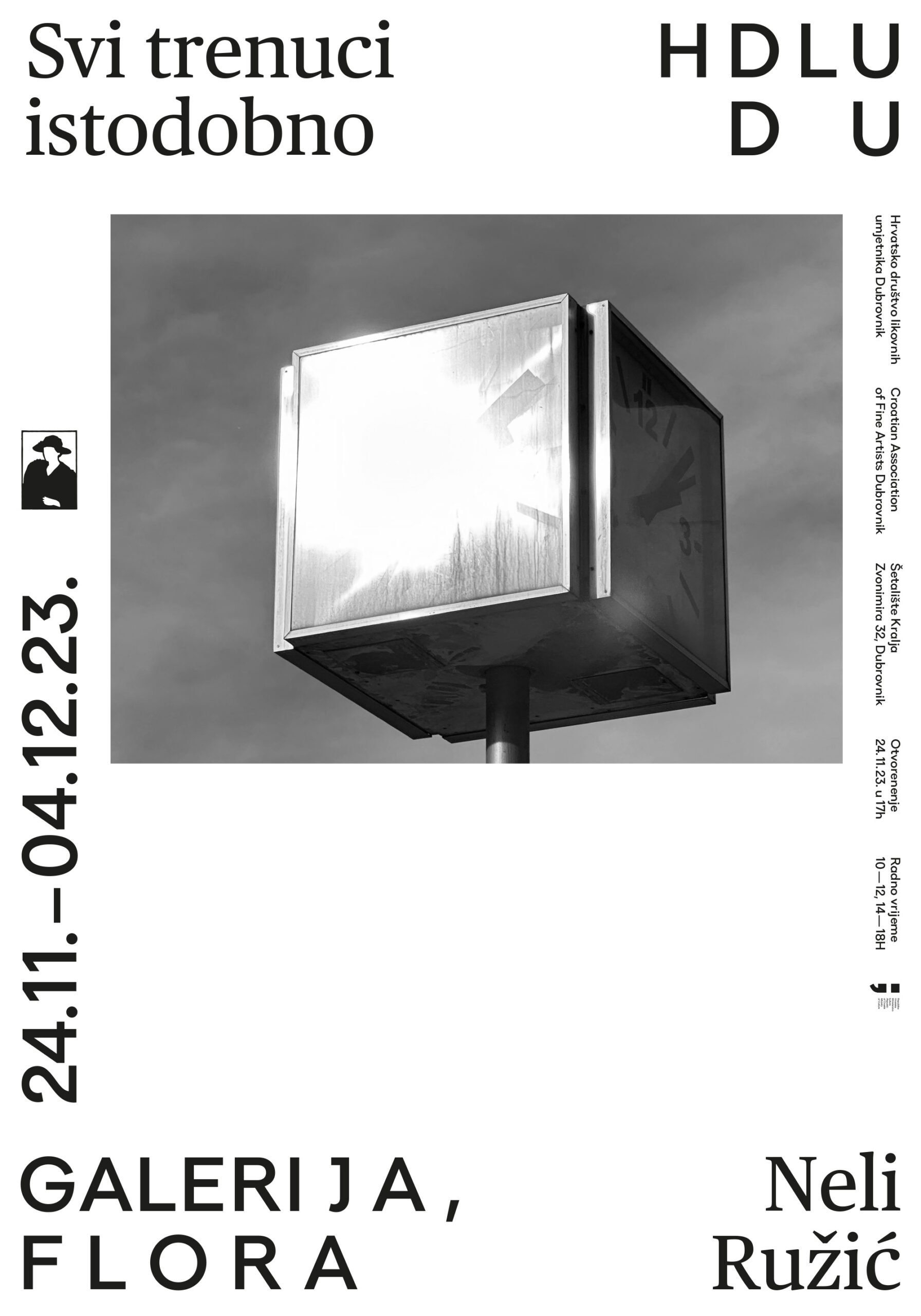Hrvatsko društvo likovnih umjetnika Dubrovnik i Galerija Flora sa zadovoljstvom Vas pozivaju na otvorenje izložbe
Neli Ružić Svi trenuci istodobno
koje će se održati u petak 24. studenog u 17 sati u Galeriji Flora.
Izložba se može pogledati do 04. prosinca svaki dan od 10 do 12 sati i od 14 do 18 sati. Izložba se može pogledati i u drugim terminima ako su vrata Florina doma otvorena, te najavom na mejl galerijaflora.dbk@gmail.com
Svi trenuci istodobno
Što bi, međutim, onda, tako gledano, bile obale vremena? Koja bi bila njegova specifična svojstva…? Na koji se način razlikuju stvari uronjene u vrijeme od onih njime nikada dodirnutih? …Zbog čega vrijeme na jednom mjestu vječno stoji, a na drugom huji i juri? …Zar ne bismo mogli reći, kazao je Austerlitz, da je vrijeme tijekom stoljeća i tisućljeća samo postalo nesinkronim? …Mrtvi su izvan vremena, kao i umirući i mnogi bolesnici koji leže kod kuće ili u bolnicama. I ne samo oni: dovoljna je već neka količina osobne nesreće da bi nas odsjekla od svake prošlosti i budućnosti. …
W.G.Sebald, Austerlitz
Umjetnička praksa Neli Ružić kontinuirano prati, arhivira i p❨r❩okazuje vrijeme, a ova izložba ujedno je i jedan od prvih retrospektivnih osvrta na dosadašnje autoričine radove koji u svojoj tematskoj bazi sagledavaju vrijeme kao historijsku činjenicu, arhivski impuls, memorijsko pomagalo i društveni normativ.
Ključno mjesto na izložbi zauzima Kronotop, novi rad otpočet 2022. godine čije autobiografske odrednice dodatno naglašava paralelno umetnuta izblijedjela, skoro pa fantomska crno-bijela fototokopija dijela autoričina lica i kose nastala 1996., Uranjanje, uhvaćena tijekom rezidencije u umjetničkom centru Headlands, što možemo sagledavati kao jednu od prijelomnih točaka unutar vremenske lente same autorice, nakon koje joj je život skliznuo i u neke nove, centralnoameričke geografije. Unutar Kronotopa pratimo i pridruženu kronologiju Florina Doma, u kojem Hrvatsko društvo likovnih umjetnika Dubrovnik kontinuirano djeluje već sedamdeset godina. Osim što takva inkluzivna gesta unutar osobne vremenske konstelacije jasno odražava kontinuirani umjetnički rad u kontekstu, direktno prokazuje i hegemone inklinacije ka prostoru Flore s kojima se HDLU Dubrovnik aktualno suočava. ¡No pasarán! jasan je stav podrške koji odzvanja s pročelja.
Kronotopom, stotinu papira formata 13 x 18 cm na kojima su uniformno otisnuti pozitivi godina, Neli Ružić kontinuirano izlaže direktnom djelovanju sunčeva svjetla. S vremenom papiri tamne, a godine blijede. No sat, kao i godina, kazuje i više od vremena, a sunce se čini ključnim akterom u tom postupku još od početka mjerenja vremena. Prisjetimo se da je po nekim starim definicijama jedan dnevni sat približno jednak dvanaestini vremena od izlaska do zalaska Sunca. Stoga ne čudi ljeskanje sata unutar recentnog opservacijskog rada Sunčani sat. Po suncu po-stoje svjetlost i viđenja, a time i znanost i istina. Nije da nam ne manjkaju ovih dana.
Na izložbi je prisutan i prvi rad iz ciklusa vremenskog razmatranja, Treće vrijeme iz 2007. godine. Crni okvir, poput kakve mjesne zidne osmrtnice dijeli se na tri jednaka dijela. Mehanizam sata naštiman je na dvije različite vremenske zone, slijeva Split UTC + 1:00, krajnje desno Mexico City UTC – 6:00 dok je crna sredina, po nekim likovnim kritičarima metafora crne rupe, velike mase zbijene u crnu točku iz koje nema povratka pa čak niti za svjetlost. Tješi me misao da je dotična crna rupa spremnik briga svih tih paralelnih stvarnosti i razdvojenih godina.
Poput vremešnog srebrnog zrcala u drvenom okviru koje je Ružić naslijedila i u koju je ugravirala Istovremeno. Ovaj obiteljski ready-made i lingvistički akcent vraća me na davno usvojene postavke revolucionarne teorije relativnosti. Vježbam mentalni elasticitet i metaforički se ogledam; je li naša budućnost isto toliko realna koliko i naša prošlost? Je li sadašnji trenutak uistinu toliko poseban koliko nas uče svi ovi priručnici samopomoći? Je li fiksiranje nečeg neodređenog jedini trenutak tog pravog nam bivanja? Moja, tvoja, naša istodobnost je već tu, iako stvari ne vidimo nužno iz istog ugla.
Društvena igra za jednog igrača ili više igrača? Dok premećem utege iz jučer u danas, razmišljam o djetinjstvu kada mi je vrijeme bilo fizički opipljivo i nije prosklizavalo poput pješčanog sata.
Postoji izvan i unutar vremena.
I oni izvan i unutar vremena. Ministarstvo sjećanja.
Kairos je možda onda ključ ove a-sinhrone izložbene enigme. S čuperastim Sada skulpturalno koketira crni metalni sat čija se kazaljka sekunde istom brzinom kreće u suprotnom smjeru od rotirajuće baze sata stvarajući iluziju nepomičnosti…
Ne tako davno fiksirale smo nebo. Rekla si da je ono što se toliko sjaji Jupiter i da je toga dana najbliži Zemlji u posljednjih 59 godina. Na samo je 33 svjetlosne minute od nas što bi značilo da vidimo na milijune kilometara u prošlost. Tu sam negdje zagubila usvojenu logiku, ali me je veselila spoznaja da je danas, osim što je naše, u mnogočemu slojevitije od pukog sadašnjeg trenutka. ( Ivana Meštrov)
All Moments at the Same Time
[…] so where, seen in those terms, where are the banks of time? What would be this river’s qualities, […]? In what way do objects immersed in time differ from those left untouched by it? […] Why does time stand eternally still and motionless in one place, and rush headlong by in another? Could we not claim, said Austerlitz, that time itself has been nonconcurrent over the centuries and the millennia? […] The dead are outside time, the dying and all the sick at home or in hospitals, and they are not the only ones, for a certain degree of personal misfortune is enough to cut us off from the past and the future.
W.G. Sebald, Austerlitz
Neli Ružić’s artistic practice continuously observes, archives, manifests and exposes time, and this exhibition is also one of the first retrospectives of the artist’s previous works, which, in their thematic core, consider time as a historical fact, an archival impulse, a mnemonic tool, and a social norm.
A central piece in the exhibition is Kronotop (Chronotope), a new work initiated in 2022. Its autobiographical elements are further accentuated by the parallel insertion of the work Uranjanje (Immersion), a faded, almost phantom-like black-and-white photocopy of a part of the artist’s face and hair captured during a residency at the Headlands Centre for the Arts. This precise moment can be seen as one of the turning points in the artist’s timeline, after which her life slipped into some new, Central American geographies. Within Chronotope, we also follow the associated chronology of Florin Dom (Flora’s Home), in which the Croatian Association of Fine Artists Dubrovnik has been continuously active for seventy years. Apart from the fact that such an inclusive gesture within the personal temporal constellation clearly reflects the continuous artistic work in the context, it also directly exposes hegemonic inclinations towards the space of Flora that the Croatian Association of Fine Artists Dubrovnik is currently facing. ‘¡No pasarán!’ is a clear stance of support that echoes from the facade.
In Chronotope, Neli Ružić continuously exposed one hundred 13 x 18 cm papers uniformly imprinted with the positives of the years to the direct action of sunlight. Over time, the papers darken, and the years fade. However, the hour, like the year, tells more than time, and the sun appears to be a crucial player in this process since the beginning of time measurement. Let us recall that, according to some old definitions, one daily hour is approximately equal to the twelfth part of the time from sunrise to sunset. Hence, it is not surprising that the gleam of the clock is visible in the recent observational work Sunčani Sat (Sundial). In the sun, there are light and visions, and thus science and truth. Not that we do not lack them these days.
The exhibition also features the first work from the series of temporal contemplations, Treće Vrijeme (Third Time) from 2007. A black frame, reminiscent of a local wall obituary, is divided into three equal parts. The clock mechanism is set to two different time zones, Split UTC + 1:00 on the left, and Mexico City UTC – 6:00 on the right, while the black centre, according to some art critics, is a metaphor for a black hole, a large mass condensed into a black point from which there is no return, not even for light. I am comforted by the thought that the said black hole is a reservoir of concerns from all these parallel realities and years apart.
Much alike an aged silver mirror in a wooden frame that Ružić inherited and engraved with the word Istovremeno (Simultaneously). This family ready-made and linguistic accent brings me back to the long-adopted tenets of the revolutionary theory of relativity. I exercise mental elasticity, engaging in a metaphorical mirror gaze: is our future as real as our past? Is the present moment truly as extraordinary as all these self-help manuals teach us? Is fixating something indeterminate the only moment of our true being? Our simultaneity, yours, mine, is already here, even though we may not necessarily see things from the same perspective.
Društvena igra za jednog igrača (Board Game for a Solo Player) or multiple players? As I rearrange weights from yesterday to today, I think about my childhood, when time was physically tangible and did not slip away like an hourglass.
There is beyond and within time.
And those beyond and within time. Ministarstvo Sjećanja (Ministry of Memories).
Kairos might be the key to this a-synchronous exhibition enigma. A black metal clock sculpturally flirts with a frizzy Now, the second hand of which moves at the same speed in the opposite direction of the rotating clock base, creating the illusion of immobility…
Not so long ago we were fixing our gaze upon the sky. You said that what shined so brightly was Jupiter and that on that day it was closest to Earth in the past 59 years. It was only 33 light minutes away from us, which would mean that we saw millions of kilometres into the past. Somewhere along the way, I lost the adopted logic, but I was happy to know that today, apart from being ours, is in many ways more layered than just the present moment. ( Ivana Meštrov)



Leave A Comment
You must be logged in to post a comment.